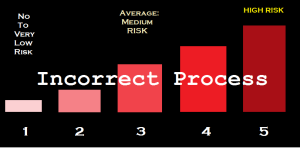WHY THE SCALE METHOD IS INCORRECT
To date, there are no set rules, no uniformed checklist or any definitive means in which to determine risk. This is highly applicable to many assessors that attempt to define risk on a grading scale and rate areas and points within a property as low to high. Many variations of such applications exist, but generally the points range from the lowest or no risk at 1 and continue up to 5, indicating high risk. Simplification of this method may rate risk in just 3 categories only.
As independent Security Risk Consultants we view all risk as equal and firmly stick to the principle that risk cannot therefore be accurately graded or summed up in this manner. One of the reasons for this is that a given risk rating is not purely objective as there are no rules and therefore depends on the assessor conducting the security inspection. Background, experience, training, relevant security knowledge and personal aspects such as belief or being a victim of a crime oneself could affect the score as deduced by the assessor, which allows for misinterpretation and ultimately incorrect conclusions.
For example, should an assessor be petite, overweight or even have a fear of heights, he / she may conclude that a particular wall is too high to climb and rate the perimeter as a 1, but a tall, strong and athletic individual who enjoys extreme sports like skydiving perhaps, would see the wall as no obstacle to himself / herself or a determined criminal, and would rate the wall higher on the scale. In the event that a crime occurs and this wall is used as access into the property, the first assessor would have been wrong and ultimately the crime would not have been prevented as a low risk rating excluded the wall from further security upgrades. Unfortunately too many companies have had such Security Risk Assessments done only to find thereafter that low rated areas were actually where incidents occur. Usually this is where the independent security advisor is called in to reassess the security status.
Consider it even further and assume that 5 assessors are asked to rate this particular wall using the scale system. For each and every one of them, a different point could be selected for whatever reason or factors their opinion was based upon. Perhaps only one could be considered correct and that was if a 5 was given. In our eyes all areas should be an automatic 5 and be considered, instead of being seen as high risk, but rather in terms of the opportunity present at this point for a crime to occur. When conducting a Threat Assessment, this is how we view risk – in regards to opportunity and not probability. This approach has proven over the years to be more accurate than the scaling system.
